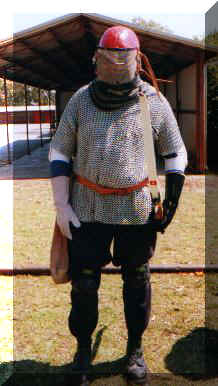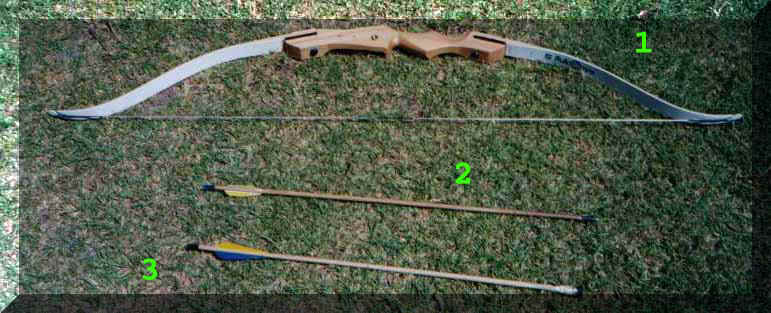
As part of the combat in the SCA, archery takes on a form of its own. The requirements are very similar to other forms of combat. You also need to know the rules of the lists and they can be found here.
In this part you can learn all about the things that make up combat archery and what is needed to pass authorisation for combat archery.
The helm should also be tight enough so that the wire mesh at the front of the helm doesn't hit the archer's nose in the case of a frontal impact as this can cause injury to the face of the archer as well.
An excellent photo of combat archery gear is below.

Me in combat archery gear.
Also, when you are on the field in archery, there are a number of commands that you need to know in case of accidents or other such incidents. They are:
In this section I will explain some of the information that is a part of combat archery. The information will be explained under separate categories.
* - Things you need to know about in order to pass authorisation.
Bows and arrows in Combat Archery

1. The standard bow.
2. A target arrow.
3. A combat arrow.
The bows used in combat archery are required to be of 25 to 30 pounds pull at full pulling of the bowstring with an arrow notched and ready to fire. They can be of any sort of design (not homemade ones though - unless you know how to make bows) which is suitable for firing arrows. The price of bows can range from cheap second-hand ones costing less than $50 to expensive authentic English longbows that cost thousands of dollars.
If a bow is hit in combat archery, it is deemed as damaged and as such cannot be used again until the current combat scenario is finished.
The crossbow used in combat archery is to have a maximum poundage draw of 600 pounds when firing a crossbow quarrel or bolt. This can be measured by the length of the quarrel at full draw on the crossbow string and multiplying that by the poundage of the crossbow string at full draw. For example, the maximum size crossbow bolt used in combat archery is 12 inches because of the poundage factor.
12 inches X 50 pound crossbow string at full draw = 600 pounds.
Using this calculation the crossbow archer can then make bolts and crossbow strings to suit the combat archery as necessary.
If a crossbow is hit in combat archery, it is deemed as damaged and as such cannot be used again until the current combat scenario is finished.
Combat archery quivers can be of any sort to carry arrows, bolts and other implements of combat archery. The best length for the quiver is to be about 2 thirds the length of the arrows to be held in it. So if the arrows are 28 inches long, the quiver should be about 19 inches long. For crossbow bolts the quiver should be about 4 fifths the length of the bolt. For example if the bolt is 12 inches long, the quiver should be about 10 inches long. I have seen people using arrow quivers to hold crossbow bolts and they have had difficulty in getting the bolts out fast enough, unless of course they had practised lots first!
If any arrows fall out of the quiver or are dropped by the combatants during combat, they are deemed as damaged and cannot be re-used until they are checked again. Along with this, if an arrow strikes the quiver it is deemed as damaged and all the remaining arrows are useless until they are checked again.
The staff sling can be made out of wood with a leather thong attached to the end of it with a loop to sling around the end of the staff to release during the swinging of the staff.
The combat archery requirement of the missiles for this weapon are tennis balls that are slit on four sides and have tape wrapped around them for reinforcement. You can also have some cloth streamers to see where the missile lands during combat for easy recovery.
To carry these missiles it is best to have a large cloth bag similar to the quiver but larger for carrying them.
The Javelin used in combat archery is vastly different to the Javelin used in real life. The SCA combat Javelin has a dense foam head weighing about 500 grams to a kilogram and is about 1 to 1.5 metres in length with the shaft being made of plastic piping and for stabilizers there are 3 or 4 foam fletches glued and taped on.
To launch the SCA Javelin, it is best to have a string attached to the middle of the shaft between the head and the fletches and for this string to be about 1 metre in length with a small loop in the end of it.
The tool used for launching the SCA Javelin is a stick with a small end used to hold the loop on the end of the string attached to the Javelin and to let the Javelin hang loose. You then aim your body in the direction you want to fire the Javelin and take a few small paces and launch the Javelin by swinging the stick over your head in a similar fashion to the Staff Sling.
It will take a lot of practice to get the targeting of the Javelin right and this sort of weapon is so bulky and large that you cannot carry many around at one time like the other missiles used in combat archery.
The arrows used in combat archery are not your everyday standard arrow. They are made of wood which is strong enough to handle the bow string of the bows used and are fletched with 3 or 4 plastic or feather stabilizers at the notched end to provide stability when flying through the air. The notches are usually plastic and can be of any colour, same with the stabilizers as well, except for reserved royal colours used by SCA royalty.
The length of the arrows that can be used in combat archery are 28 inches and they have a 3/4 inch rubber tipped head for hitting the targets in combat archery. You cannot used target arrows in combat archery because they have sharp points and are considered dangerous to use, similarly the blunt arrows used in combat archery cause damage to the targets and are therefore not suitable for target practice.
If any arrows fall out of the quiver or are dropped by the combatants during combat, they are deemed as damaged and cannot be re-used until they are checked again. Along with this, if an arrow strikes the quiver it is deemed as damaged and all the remaining arrows are useless until they are checked again.
If, during the combat, you have an opponent come up to you while you are lying on the ground 'dead' and ask you if they can use your remaining arrows, you can either accept or decline the offer and if you decline the offer there is no need to feel bad or guilty about saying so and they should likewise.
Quarrels (crossbow arrows/bolts)
The crossbow bolts are similar to the arrows used in combat archery except they are shorter and can fly over greater distances, although this is open to dispute. The size of the bolts are generally 12 inches because of the poundage of the crossbow string at full draw.
The bolts also have the same size tips as used on arrows except that they may not have notches at the fletched end because the crossbow has no need to be released by hand as like the bow does.
If any quarrels fall out of the quiver or are dropped by the combatants during combat, they are deemed as damaged and cannot be re-used until they are checked again. Along with this, if a quarrel strikes the quiver it is deemed as damaged and all the remaining arrows are useless until they are checked again.
The field that is used for combat archery can be any open space of at least 40 metres in length and about 20 metres wide. The archers take up position at the opposite ends of the field and when they are ready, commence firing.
When an opponent comes within 5 metres of the archer, the archer cannon fire an arrow under any circumstances as any distance under 5 metres is deemed to be lethal by SCA standards. If you find yourself in this situation, back away from the opponent until you are over 5 metres away or you surrender or 'yield' to your opponent.
If any unauthorised person or animal comes onto the combat field, all combatants must take the 'hold' position until the all clear is given by the combat archery marshals.
Incapacitation and killing body sections
With combat archery, you need to know the different areas of the body that can get hit. The system used by the SCA for counting body hits is dependant on the person getting hit being honest in knowing whether the blow was a killing or incapacitating blow or if it didn't even hit them at all. From time to time there will be hits that you won't feel but you will be told of them by the other participants in the combat after it has finished. This system is used to promote safe and equal fun for all participants so if a person cheats it is not deemed fair for anyone else fighting them!
For the counting of blows to the body you must first realise that the different parts of the body are not all the same, some parts are much more delicate than other parts!
- The head, neck and main torso are locations where, if you get hit, it is an instant kill, as the force of the arrow is enough to penetrate armour if you were using real arrow tips in combat. When you get hit in these areas, it is best to fall over flat and facing up or to the side with the bow and quiver of arrows to the side of you so that you don't break them.
- The legs up to the buttocks and the arms up to the shoulders are body parts where you will be incapacitated if you get hit in combat and if you get hit in these areas, either lock that limb behind your back in the case of the arms or lock the leg straight or kneel down on the leg that got hit.
Once the combat has finished, discuss with the other participants who took part to find out what they thought, felt, etc to enable you to held improve your view of the combat that took place. People will make mistakes and by talking it over at the end of the combat round you can learn how you went and what you did wrong or right and how to improve for the next round.
To return to the main SCA page click on the Back icon below.